A cultural movement in search of a political movement meets a political movement in search of an artistic force.
They say every movement has its soundtrack; but this film metaphor doesn’t come close to capturing the way that music’s unique combination of word and sound has been integral to progressive and radical change throughout the century. From South Africa’s anti-apartheid movement, to the freedom songs of the US civil rights struggle, musical rhythms have fueled the very heartbeat of social movements — strengthening bonds within groups, creating space to connect across racial and cultural lines, educating about issues, engaging emotions, and tapping into deeply held political and spiritual beliefs.
The Occupy Wall Street movement, and the larger anti-capitalist sentiment from which it derives its strength, does not have a coherent soundtrack. While musicians of all stripes have taken the movement and its “99%” message as inspiration, and arts of many kinds have popped up at occupation sites, there is no set of “occupation songs” that drive the movement. This may in part be a result of the very wide net the movement is trying to draw — certainly 99% of the population could never agree on liking the same music. But if I had to put my money on one genre that has the potential to unite young occupiers across the country, and the world, it would be hip-hop music — with its wide appeal, roots in rebelliousness, and long history of political and social critique (sorry, folk music).
Meanwhile, conscious hip-hop has long been a cultural movement in search of a political one. (more…)





